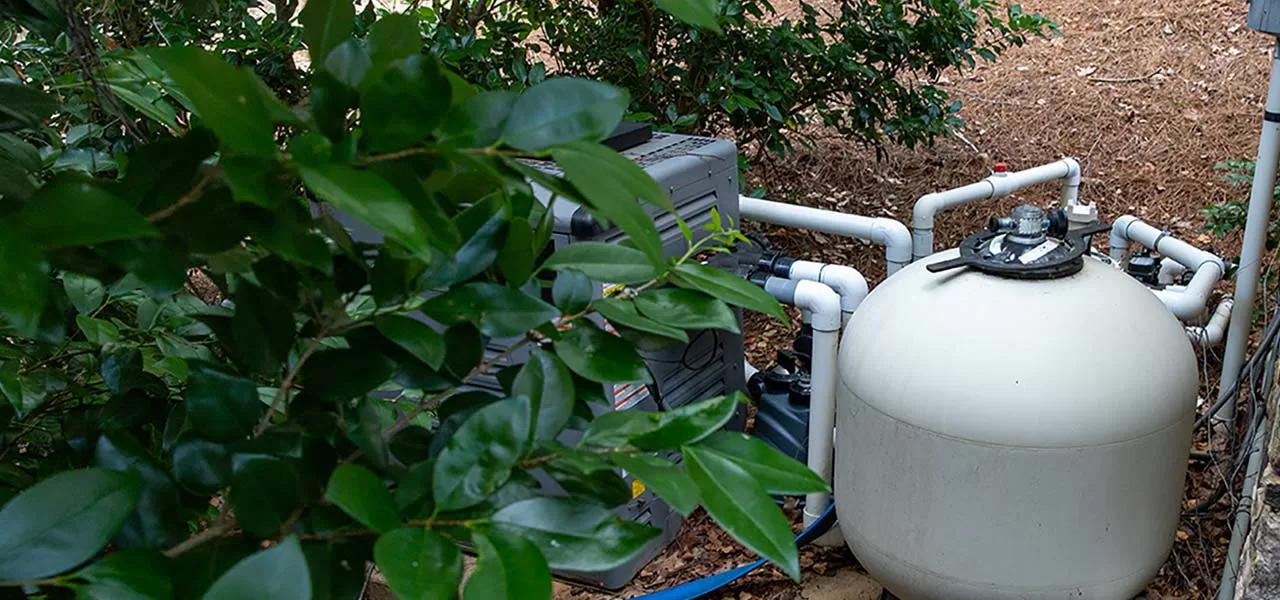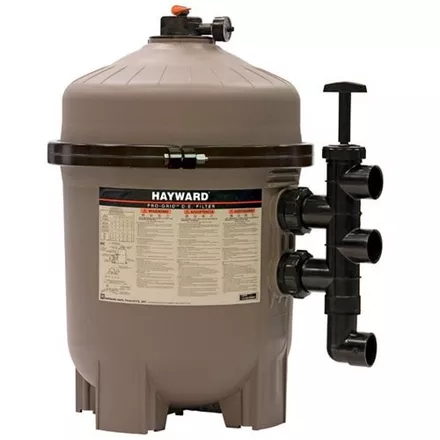FREE Standard Shipping On All Orders $100 or More!*

9 Ways to Improve Your Pool Filtration
For those of you who have a pool filter that is somewhat, shall we say, marginal, this post is for you. Many pool filters out there are either too small for the pool, not extremely efficient, or they're just plain worn out. Others work fine for most of the year, but may have trouble during spring clean-up or warmer temperatures. Even if your filter is brand new, correctly sized, and you've never had an issue, you can never go wrong with improving the efficiency of your pool filtration. The only consequence is you'll have cleaner, clearer water. That doesn't sound so bad, does it?!
If you're looking to get the best performance of your swimming pool filter, we've got a few tips you can use on your cartridge, sand, or D.E. filters.
Is Your Filter the Right Size?
Before we get into the different ways to improve filtration efficiency in your pool, consider whether or not your filter may be undersized. As a general rule of thumb, there's no such thing as too big of a filter, only one that's too small or just right. To pick the right size of filter, consider the flow rate of your pump and the size of your pool. You'll find more information about filter sizing in our blog post, How to Size a Pool Filter.
Cartridge Pool Filters
A cartridge pool filter has one or more pleated cartridges. The water is forced into the pleats. Here, it leaves behind dirt and debris, which gets trapped within the folds. As the pressure rises on the filter tank gauge, the flow rate decreases. Eventually, the cartridge is removed, hosed clean, and the cycle begins anew.
If dirt and debris end up back in the pool, it may be bypassing your filter cartridge. Look for rips in the pleats or cracks in the plastic ends of your cartridge. Another cause of dirt getting around the cartridge (and not through it) are misplaced or misaligned parts within the filter. Look to your filter's owner's manual to identify the location and placement of internal manifolds. Check these internal parts for cracks or missing o-rings. Sometimes it's just a matter of properly "seating" the cartridge into the base of the filter tank before you put the lid back on.
You may notice that your filter cartridges lose efficiency over time. This is because each time you clean your cartridge, the fibers become looser and it loses just a bit of its filtering ability. After around 20 cleanings, or every 2-3 years, consider replacing your filter cartridges with new ones. In the meantime, there are a few things you can do to improve pool filtration and keep the filter running as efficiently as possible:
3 Ways To Improve Cartridge Pool Filter Performance
1. Filter Cleaner
The best treatment for overworked filter cartridges is to regularly use Granular Filter Cleaner. Soak your filter cartridge overnight to take cleanse pleats that are clogged with minerals or oily residue. After soaking, rinse the cartridge thoroughly, and reinstall. If you struggle with lots of oily substances in the pool (suntan oil, cosmetics, hair products, natural body oils, etc.), use a pool enzyme product, such as Pool Perfect, to break them down and prolong the life of your filter media.
2. Water Clarifier
Adding a clarifier to your pool water can help pool filters immensely. Pool clarifiers act as coagulants, clumping very tiny particles together into larger clumps that are more easily filtered. Be careful not to overdose, however. Using too much clarifier can cause the opposite effect, dispersing the particles and make your water appear cloudy. As with any pool chemical, carefully read and follow all product label instructions before adding to the pool.
3. Pulp Fiber
Adding a small amount of Jack's Magic Filter Fiber Stuff to your skimmer can help your pool filter cartridge to trap more fine dirt and debris. You just need a small amount, only 3 oz. per 25 sq. ft. of filter area. Do NOT use DE Powder or Perlite in your cartridge filter, because these have very sharp edges that can cut the microscopic fibers of your filter fabrics, damaging the filter beyond repair.
Sand Pool Filters
Sand pool filters are the simplest to operate, the easiest to maintain, and often the least expensive to purchase. Even those intimidated by their pool equipment can manage to backwash a sand filter. Sand filters have a simple design. Water is pumped into the top of the tank, pushed through the sand bed, then it flows into the slotted pipes in the bottom of the tank. The dirt is left behind, trapped in the sand bed. To remove the dirt, reverse the flow and backwash it out of the filter tank.
Sand filters are not perfect, however, and they lack the same level of efficiency as you'll find in a cartridge or D.E. filter. Sometimes sand filters can allow very fine debris to pass through, but your can improve the filtration ability in your pool with a few simple methods.
If you notice that your filtering efficiency has gone completely out the window, it probably has to do with the sand itself or a problem with the filter internals. Just like with the cartridge filter, you may need to check for cracks and signs of damage, especially if you're noticing sand in the pool. If the sand is older than 5 years, consider replacing it with new sand or a suitable alternative like Zeo-Sand.
Other common issues with sand filters include mud-balling, which is when oily balls of sand collect at the top of the filter. Remove the balls by hand, and replace the amount with fresh filter sand. Sometimes you can also eliminate the balls with Granular Filter Cleaner, which we mentioned in the previous section. If the pump is too powerful for your filter, channeling in the sand can cause the water to pass through unfiltered. Also, if your water is particularly hard, your sand may form rock-hard calcified chunks that reduce filtration ability.
3 Ways To Improve Sand Pool Filter Performance
1. Filter Cleaner:
Sand filter cleaners work a bit differently than D.E. and cartridge filter cleaners, in that they can be stronger and harsher against oily buildup and calcification without damaging the filter media (sand). You'll also use them a bit differently. For best results, use Sand Filter Cleaner before every backwash, letting it soak in for a few hours or overnight if possible.
2. Aluminum Sulfate:
Known as Alum in the trade, Aluminum Sulfate forms a gelatinous material when mixed with water. You can often find it at your local pool supply store or online. Use 1 pound of Alum per square foot of pool filter area, and add it slowly into the pool skimmer. This brings the material to the sand bed, where it will spread out and stop. Water then passes through the layer of Alum, leaving behind the very small particles that ordinarily would not be filtered out.
3. The Slime Bag:
Using the Slime Bag is almost like adding a secondary filter to your pool. All sand filters will bypass very fine, silty dust, and this is normal. Use the Slime Bag for quick spring clean-up, algae recovery, or when dealing with small mudslides. The Slime Bag is a fine mesh fabric filter bag that attaches to wall returns. If you don't have a Slime Bag to use, you can always wait for the dust to settle (Alum helps!), then vacuum to waste.
Diatomaceous Earth Pool Filters
D.E. pool filters are known to be superior to the other two types of pool filters in terms of their particle size filtering ability. The biggest downside is that they're the most expensive type of filter to buy, and they are a bit more work to maintain. But these factors pale in comparison to the filtration efficiency you'll get with a D.E. filter. Even though it's the best type of pool filter available, you can still improve its filtration abilities.
If your D.E. filter isn't working so well, it requires frequent backwashing, or if you're noticing D.E. powder blowing into the pool, there are a few things you can do. First, remove the grid assembly from the tank and hose it off thoroughly. If it's extremely dirty and clogged, soak it in D.E. Filter Cleaner or Filter Perfect. Inspect the grid assembly for signs of damage, like fabric rips, manifold cracks, or a missing air bleeder, and replace parts as needed. Check the o-ring on top of the standpipe inside the tank to make sure it's not missing. Also check the multiport or push-pull valve for cracks and worn o-rings/gaskets.
Place the grids back into the tank, and add the correct amount of D.E. powder through the skimmer. Since you just finished a complete cleaning, you'll need a "full charge" of powder, which is more than what you use after a simple backwashing.
3 Ways To Improve D.E. Pool Filter Performance
Enzymes
Cellulose Fiber

Filter Bumping
1. Pool Enzymes
Oils can be a problem in any pool filter, but can really clog up the fabric used in D.E. filter grids. Using an enzyme product like Pool Perfect will remedy the situation. They use the same types of enzymes for ocean oil spills, so you know it's good stuff that can handle heavy duty jobs.
2. Cellulose Fiber:
Cellulose is an alternative filter powder for use in D.E. pool filters, replacing diatomaceous earth. Volcanic in origin, Cellulose is all-natural. It provides greater surface area, offering greater coverage with less bridging between grids and more complete backwashing. Cellulose is also lighter than D.E., meaning it's easier to handle.
3. D.E. Filter Bumping:
This one's not a product, but rather a method. Hayward Perflex filter owners are familiar with "bumping" the filter. But if you have a multiport or slide valve on your D.E. filter, this may be a new concept. It's a way to lower filter pressure, raise water flow, and improve D.E. filtration ability.
Bumping a non-Perflex filter is just a very short backwash, only for 5-10 seconds. It's just long enough for D.E. powder to begin discharging into the waste line. Next, turn off the pump, and place the valve back into the filter position. You will notice lower filter pressure when you turn the pump back on again, but should not have lost much D.E. powder (if so, add a cup or two). For a more complete D.E. filter bumping, do the filter-backwash-filter process two or three more times, all very briefly.
These are just a few of the ways you can easily improve filtration efficiency and boost the ability of your pool filter. As you'll notice, some of the products listed are suitable for any filter. The main exception is that a few are only useable for certain filter types. If you are having trouble with water clarity, but the pool is well balanced and sanitized, look to the filter. There's a chance that the filter could be the source of your water clarity problems!